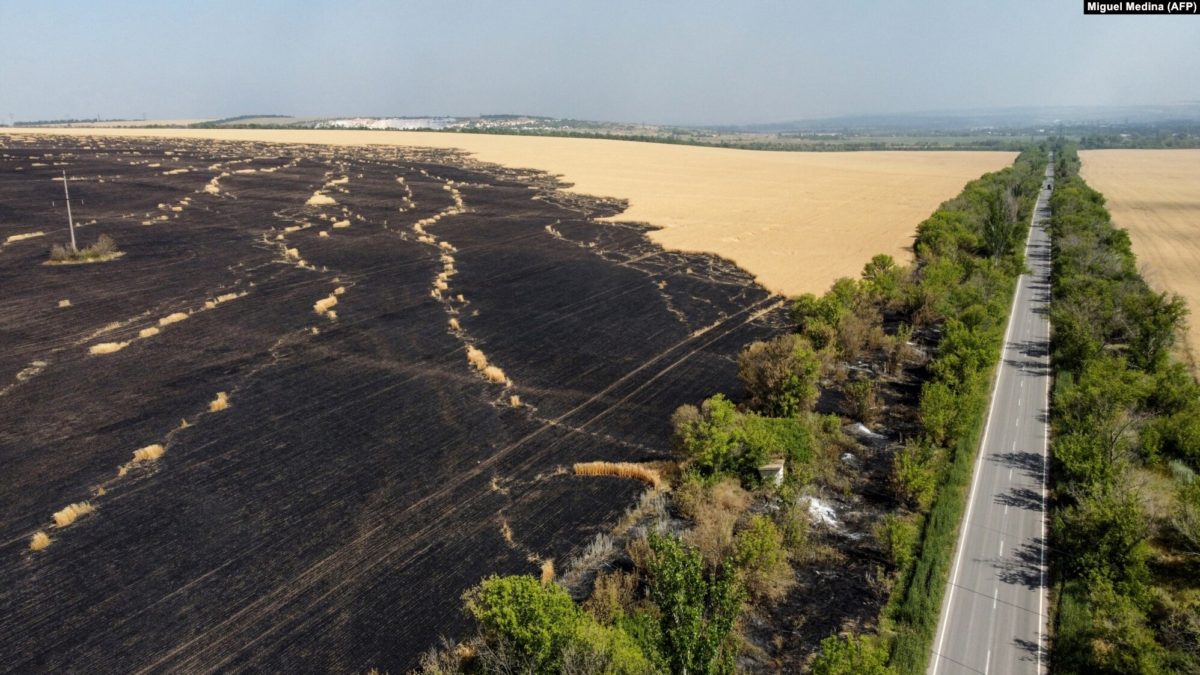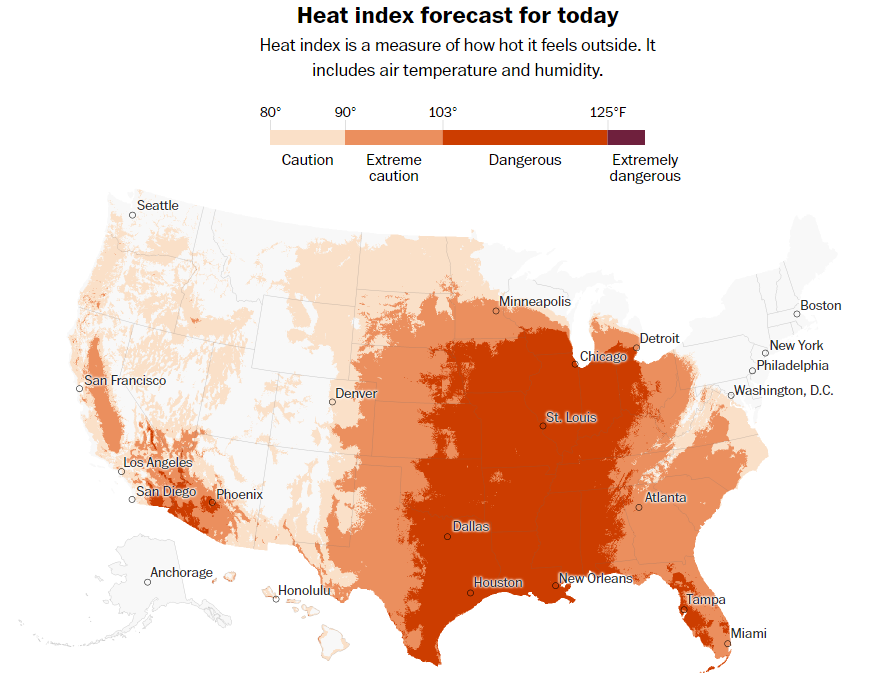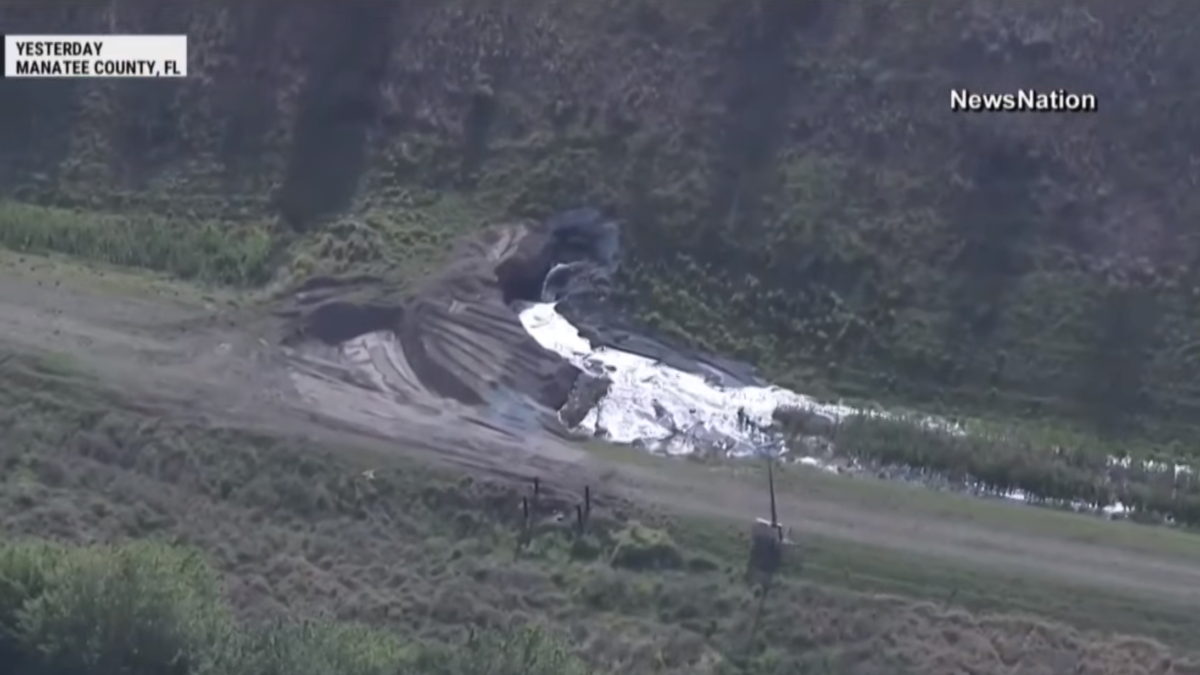World scientists’ warning of a climate emergency 2021 – Humans face untold suffering from “the consequences of unrelenting business as usual”
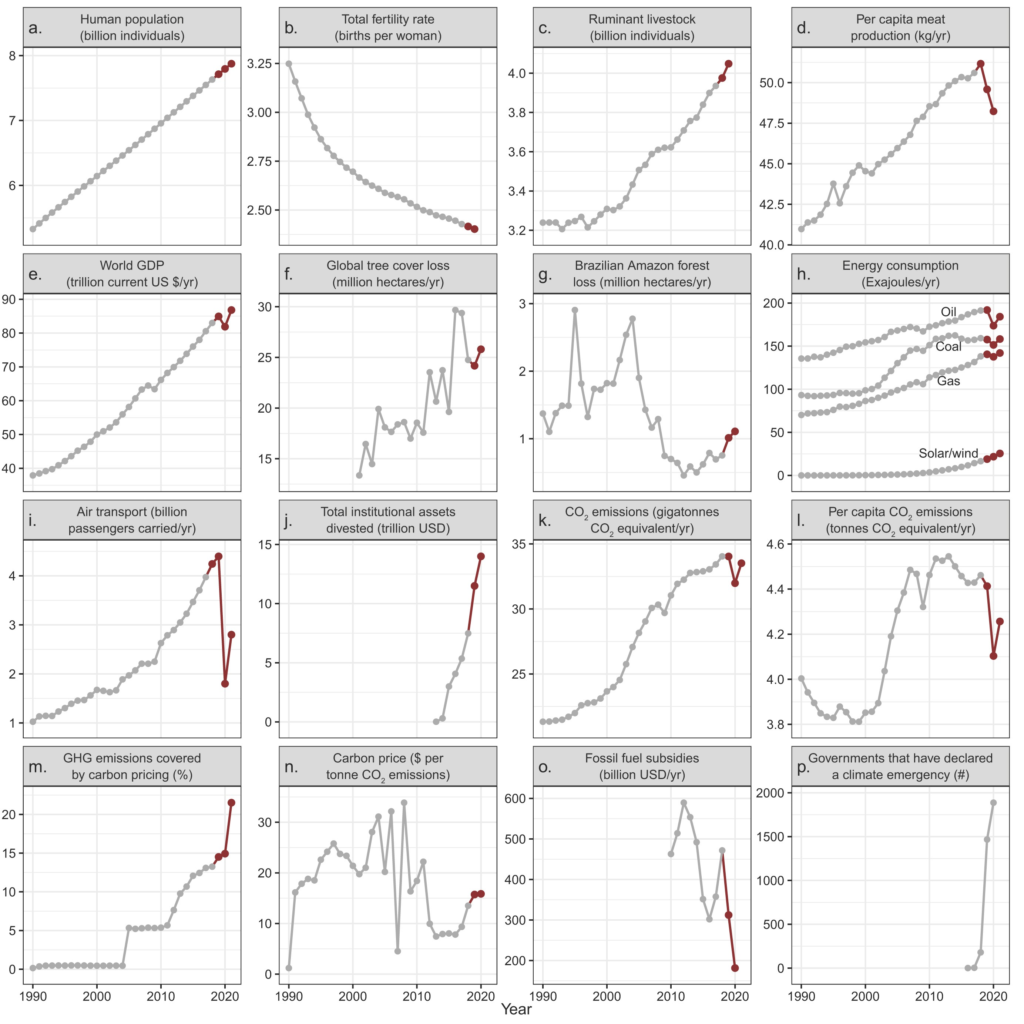
28 July 2021 (BioScience) – In 2019, Ripple and colleagues (2020) warned of untold suffering and declared a climate emergency together with more than 11,000 scientist signatories from 153 countries. They presented graphs of planetary vital signs indicating very troubling trends, along with little progress by humanity to address climate change. On the basis of these data and scientists’ moral obligation to “clearly warn humanity of any catastrophic threat,” they called for transformative change. Since the article’s publication, more than 2,800 additional scientists have signed that declaration of a climate emergency (see supplemental file S1 for the current signatory list); in addition, 1,990 jurisdictions in 34 countries have now formally declared or recognized a climate emergency (figure 1p). But, at the same time, there has been an unprecedented surge in climate-related disasters since 2019, including devastating flooding in South America and Southeast Asia, record shattering heat waves and wildfires in Australia and the Western United States, an extraordinary Atlantic hurricane season, and devastating cyclones in Africa, South Asia, and the West Pacific (see supplemental file S2 for attribution information). There is also mounting evidence that we are nearing or have already crossed tipping points associated with critical parts of the Earth system, including the West Antarctic and Greenland ice sheets, warm-water coral reefs, and the Amazon rainforest (supplemental file S2). Given these alarming developments, we need short, frequent, and easily accessible updates on the climate emergency.
Recent trends in planetary vital signs
In the present article, we investigate recent changes in planetary vital signs since the publication of Ripple and colleagues (2020). Out of the 31 variables that we track, we found that 18 are at new all-time record lows or highs (supplemental table S1). Below are noteworthy recent patterns in potential climate drivers (figure 1) and impacts (figure 2):
Food. For the first time, world ruminant livestock numbers soared past 4 billion, which represents much more mass than all humans and wild mammals combined (figure 1c). However, recent per capita meat production (figure 1d), declined by about 5.7% (2.9 kilograms per person) between 2018 and 2020, likely because of an outbreak of African swine fever in China that reduced the pork supply. Future declines in meat consumption and production will probably not happen until there is a general shift to plant-based diets or increases in the use of meat analogs (substitutes), which are growing in popularity and projected to be worth US$3.5 billion globally by 2026 (MarketsandMarkets 2020).
Amazon forest. The Brazilian Amazon annual forest loss rate increased in 2019 and 2020, reaching a 12-year high of 1.11 million hectares destroyed (figure 1g). The increase was likely because of weakening deforestation enforcement triggering a sharp spike in illegal land clearing for cattle and soy farming (Junior, et al., 2021). Forest degradation due to fires, drought, logging, and fragmentation has caused this region to act as a carbon source rather than a carbon sink (Qin, et al., 2021).
Climate economics. Global gross domestic product dropped by 3.6% in 2020 in response to the COVID-19 pandemic, but it is now projected to be at an all-time high (figure 1e). There was a strong increase in fossil fuel divestment; it increased by US$6.5 trillion between 2018 and 2020 (figure 1j), while, at the same time, fossil fuel subsidies dropped to a record low of US$181 billion in 2020—a 42% decline from 2019 levels—likely because of reduced energy use and prices (figure 1o). The percentage of greenhouse gas emissions covered by carbon pricing is projected to increase from 14.4% to 23.2% between 2018 and 2021 (figure 1m). Much of this increase is due to a proposed carbon pricing scheme by China, which is still rapidly building many coal plants and is now responsible for more emissions than the entire developed world (supplemental table S2; Rhodium Group 2021). The global emissions-weighted average price per tonne of carbon dioxide has remained too low (US$15.49 as of 2020), and it would need to increase severalfold to be highly effective in curbing fossil fuel use (figure 1n).
Energy use. Likely because of the COVID-19 pandemic, fossil fuel energy consumption has decreased since 2019, along with carbon dioxide emissions, per capita emissions of carbon dioxide, and air transport (figure 1h, 1i, 1k, 1l). However, these declines appear to be transient in that 2021 projected estimates show all of these variables significantly rising again. Conversely, solar and wind power consumption increased by 57% between 2018 and 2021, but it is still roughly 19 times lower than fossil fuel consumption (figure 1h). The number of air transport passengers dropped by a sizable 59% in 2020 because of COVID-19, but more than a third of this loss is projected to be recovered in 2021 (figure 1i).
Greenhouse gases and temperature. Three important greenhouse gases, carbon dioxide, methane, and nitrous oxide, all set new year-to-date records for atmospheric concentrations in both 2020 and 2021 (figure 2a–2c). In April 2021, carbon dioxide concentration reached 416 parts per million, the highest monthly global average concentration ever recorded. The year 2020 was the second hottest year on record, and all five of the hottest years on record have occurred since 2015 (figures 2d and S3d).
Melting ice. Greenland and Antarctica recently showed new year-to-date all-time record low levels of ice mass (figure 2f, 2g). In 2020, the minimum summer Arctic sea ice was at its second smallest extent on record, and glacier thickness also set a new all-time low (figure 2e, 2h). Glaciers are melting much faster than previously believed; they are losing 31% more snow and ice per year than they did just 15 years ago (Hugonnet, et al., 2021).
Ocean changes. Both ocean heat content and sea level set new records (figure 2i, 2k). Ocean pH reached its second lowest year-to-date average value on record, just behind 2012 (figure 2j). This is troubling given that coral resilience to ocean acidification is likely reduced by thermal stress and more than 500 million people depend on coral reefs for food, tourism, or tropical storm surge protection (Hoegh-Guldberg 2011).
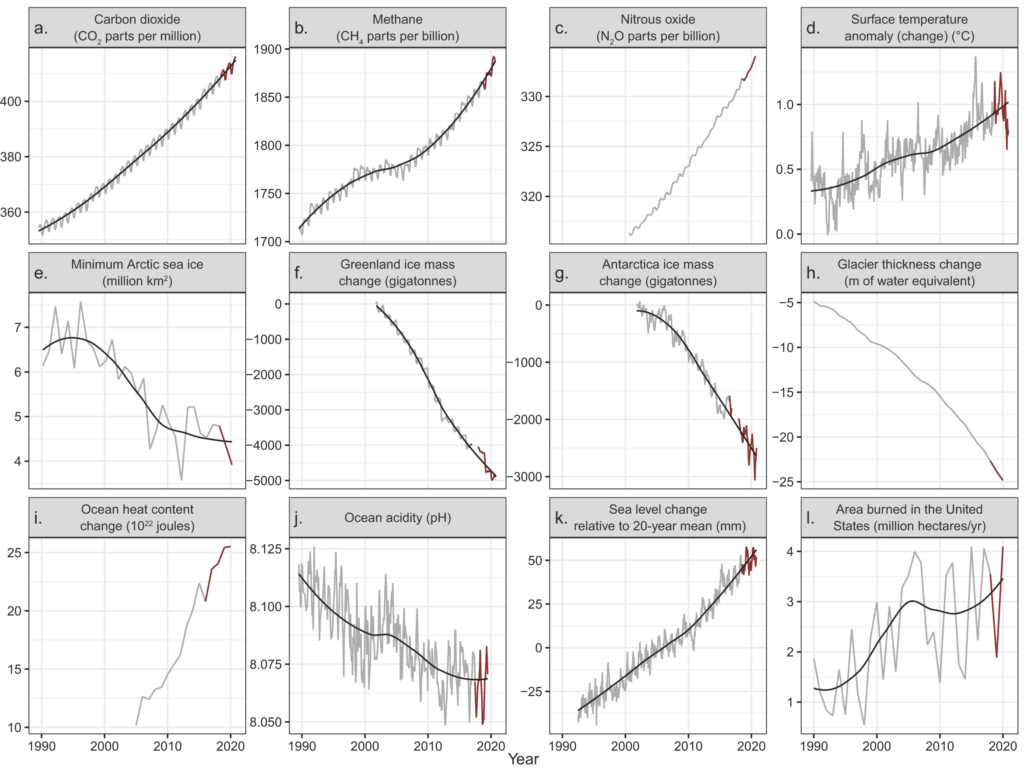
Climate policy
The updated planetary vital signs we present (figures 1 and 2) largely reflect the consequences of unrelenting business as usual. Even the effects of the unprecedented COVID-19 pandemic on some climate-related human activities (figure 1d, 1e, 1h, 1i, 1k, 1l) were short lived. A major lesson from COVID-19 is that even colossally decreased transportation and consumption are not nearly enough and that, instead, transformational system changes are required, and they must rise above politics. Despite positive intentions to “build back better” by directing COVID-19 recovery investments toward green policies, only 17% of such funds have been allocated to a green recovery as of 5 March 2021 (OECD 2021). Given the impacts we are seeing at roughly 1.25 degrees Celsius (°C) warming, combined with the many reinforcing feedback loops and potential tipping points, massive-scale climate action is urgently needed. The remaining carbon budget for 1.5°C was recently estimated to have a 17% chance of being negative, indicating that we may already have lost the opportunity to limit warming to this level without overshoot or risky geoengineering (Matthews et al. 2021). Because of the limited time available, priorities must shift toward immediate and drastic reductions in dangerous short-lived greenhouse gases, especially methane (UNEP/CCAC 2021).
We need to stop regarding the climate emergency as a stand-alone environmental problem. Global heating, although ruinous, is not the sole symptom of our present struggling Earth system but is only one of the many facets of the accelerating environmental crisis. Policies to alleviate the climate crisis or any of the other threatened planetary boundary transgressions should not be focused on symptom relief but on addressing their root cause: the overexploitation of the Earth (Rockström, et al., 2009). For example, by halting the unsustainable exploitation of natural habitats (described below), we can simultaneously reduce zoonotic disease transmission risks, conserve biodiversity, and protect carbon stocks (IPBES 2020). So long as humanity’s pressure on the Earth system continues, attempted remedies can only redistribute this pressure. [more]
